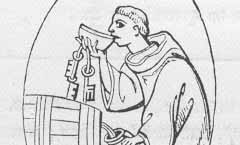
 |
| WHERE DID THE ROMANTICS DRINK? The years 1780-1830 are usually thought of as the Romantic period. However literature from the Romantics rarely offers anything to do with taverns, although lots to do with 'drink' (the god 'Bacchus'). 'The immortal dinner', given by Benjamin Haydon, is testimony to this private celebration. Wordsworth, the most revered poet of his day, was a water-drinker (like his mentor Milton), and his Dove Cottage was a converted alehouse. His Benjamin the Waggoner, a little thought-of poem then and now, is a story about a man brought down by his fondness for conviviality, and I have included it in its entirety because of the key role the hostelry plays and for the interest putting it in the context of literature, drink and England generates. The drinking places referred to in the poem were actual, and The Swan at Grasmere is still extant. Lamb was a (nearly self-confessed) drunkard, whilst his references to the Salutation and Cat where he and Coleridge used to drink haunt the early letters as a lost golden age. However, most of the drinking - as befitted their class - would have been done at home. The best and most entertaining record we have is Benjamin Haydon's description of 'The Immortal Dinner Party', with the likes of Lamb, Keats and Wordsworth gathered together and indulging in drink and genius. If the Romantics found taverns etc beneath them, there is nevertheless plenty of literature from the period which offers scenes from inns, taverns and alehouses. Reluctantly, Crabbe devotes a Letter in The Borough (1810) to inns. Goldsmith provides an idyll in his hostelry at Auburn in The Deserted Village, whereas Cowper rails against alehouses in The Task. |